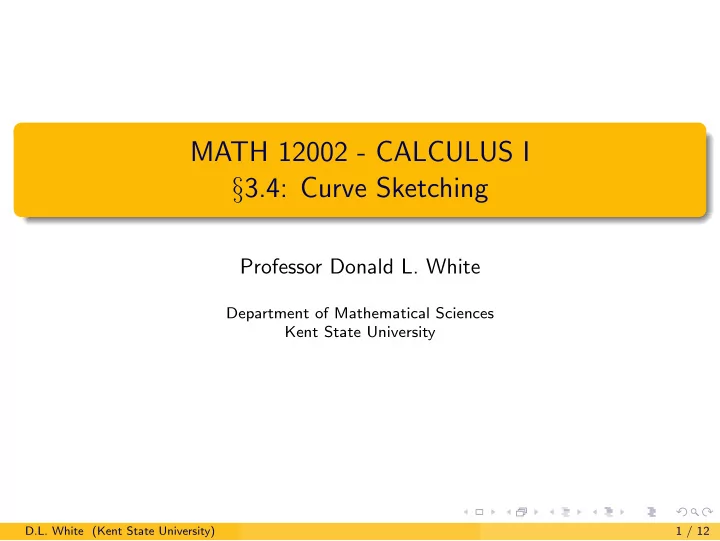

MATH 12002 - CALCULUS I § 3.4: Curve Sketching Professor Donald L. White Department of Mathematical Sciences Kent State University D.L. White (Kent State University) 1 / 12
Example 1 Example 1 Let x f ( x ) = x 2 − 9 . Determine intervals where f is increasing, intervals where f is decreasing, the location of all local maxima and minima, intervals where f is concave up, intervals where f is concave down, the location of all inflection points, and all vertical and horizontal asymptotes. D.L. White (Kent State University) 2 / 12
Example 1 We need to determine the signs of f ′ and f ′′ for f ( x ) = x x 2 − 9 . First, 1 · ( x 2 − 9) − x · 2 x f ′ ( x ) = ( x 2 − 9) 2 x 2 − 9 − 2 x 2 = ( x 2 − 9) 2 − x 2 − 9 = ( x 2 − 9) 2 − ( x 2 + 9) = ( x + 3) 2 ( x − 3) 2 Hence f ′ ( x ) is never 0 and f ′ ( x ) is undefined when x = − 3 or x = 3. D.L. White (Kent State University) 3 / 12
Example 1 Using f ′ ( x ) = − ( x 2 +9) ( x 2 − 9) 2 , we have − 2 x ( x 2 − 9) 2 + ( x 2 + 9) · 2( x 2 − 9) · 2 x f ′′ ( x ) = ( x 2 − 9) 4 − ( x 2 − 9) + ( x 2 + 9) · 2 ( x 2 − 9)(2 x ) � � = ( x 2 − 9) 4 − x 2 + 9 + 2 x 2 + 18 � � 2 x · = ( x 2 − 9) 3 2 x · ( x 2 + 27) = ( x + 3) 3 ( x − 3) 3 . Hence f ′′ ( x ) = 0 when x = 0 and f ′′ ( x ) is undefined when x = − 3 or x = 3. D.L. White (Kent State University) 4 / 12
Example 1 − ( x 2 +9) 2 x · ( x 2 +27) x f ( x ) = x 2 − 9 , f ′ ( x ) = ( x +3) 2 ( x − 3) 2 , f ′′ ( x ) = ( x +3) 3 ( x − 3) 3 0 3 − 3 − 1 − − − − x 2 + 9 + + + + ( x − 3) 2 + + + + 0 ( x + 3) 2 + + + + 0 ✲ f ′ ( x ) − X − − X − 2 x − − 0 + + x 2 + 27 + + + + ( x − 3) 3 − − − + 0 ( x + 3) 3 − + + + 0 ✛ f ′′ ( x ) + + − X 0 − X ✲ X X D D D D Inc-Dec ✛ X X D U D U Concave INF ✟ ✡ ✟ ✡ Shape D.L. White (Kent State University) 5 / 12
Example 1 − ( x 2 + 9) 2 x · ( x 2 + 27) x x 2 − 9, f ′ ( x ) = ( x + 3) 2 ( x − 3) 2 , f ′′ ( x ) = f ( x ) = ( x + 3) 3 ( x − 3) 3 − 3 0 3 D D D D Inc-Dec X X D U D U Concave X X INF ✟ ✡ ✟ ✡ Shape f is decreasing on ( −∞ , − 3) ∪ ( − 3 , 3) ∪ (3 , ∞ ); f has no local minimum or local maximum. f is concave up on ( − 3 , 0) ∪ (3 , ∞ ); f is concave down on ( −∞ , − 3) ∪ (0 , 3); f has an inflection point at x = 0. D.L. White (Kent State University) 6 / 12
Example 1 In order to sketch the graph of f , we will need to plot the points whose x coordinates are in the sign chart: x f ( x ) = x 2 − 9 is undefined at x = − 3 and x = 3; 0 0 f (0) = 0 2 − 9 = − 9 = 0. Hence the point (0 , 0) is on the graph. x Horizontal Asymptotes: f ( x ) = x 2 − 9 and the numerator of f has lower degree than the denominator. Hence y = 0 is the horizontal asymptote. x Vertical Asymptotes: f ( x ) = ( x +3)( x − 3) and the denominator is 0 when x = − 3 and when x = 3, and the numerator is not. Hence x = − 3 and x = 3 are vertical asymptotes. D.L. White (Kent State University) 7 / 12
Example 1 0 3 − 3 D D D D Inc-Dec X X D U D U Concave X X INF ✟ ✡ ✟ ✡ Shape ✻ ✛ ✲ q − 6 − 3 (0 , 0), INF 3 6 ❄ D.L. White (Kent State University) 8 / 12
Example 1 D.L. White (Kent State University) 9 / 12
Example 1 D.L. White (Kent State University) 10 / 12
Example 1 D.L. White (Kent State University) 11 / 12
Example 1 D.L. White (Kent State University) 12 / 12
Recommend
More recommend